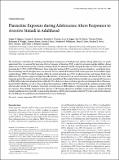Fluoxetine Exposure during Adolescence Alters Responses to Aversive Stimuli in Adulthood
Author(s)
Iniguez, Sergio D.; Alcantara, Lyonna F.; Warren, Brandon L.; Riggs, Lace M.; Parise, Eric M.; Vialou, Vincent; Wright, Katherine N.; Dayrit, Genesis; Nieto, Steven J.; Wilkinson, Matthew B.; Lobo, Mary Kay; Neve, Rachael L.; Nestler, Eric J.; Bolaños-Guzmán, Carlos A.; ... Show more Show less
DownloadIniguez-2014-Fluoxetine Exposure.pdf (2.715Mb)
PUBLISHER_POLICY
Publisher Policy
Article is made available in accordance with the publisher's policy and may be subject to US copyright law. Please refer to the publisher's site for terms of use.
Terms of use
Metadata
Show full item recordAbstract
The mechanisms underlying the enduring neurobiological consequences of antidepressant exposure during adolescence are poorly understood. Here, we assessed the long-term effects of exposure to fluoxetine (FLX), a selective serotonin reuptake inhibitor, during adolescence on behavioral reactivity to emotion-eliciting stimuli. We administered FLX (10 mg/kg, bi-daily, for 15 d) to male adolescent [postnatal day 35 (P35) to P49] C57BL/6 mice. Three weeks after treatment (P70), reactivity to aversive stimuli (i.e., social defeat stress, forced swimming, and elevated plus maze) was assessed. We also examined the effects of FLX on the expression of extracellular signal-regulated kinase (ERK) 1/2-related signaling within the ventral tegmental area (VTA) of adolescent mice and Sprague Dawley rats. Adolescent FLX exposure suppressed depression-like behavior, as measured by the social interaction and forced swim tests, while enhancing anxiety-like responses in the elevated plus maze in adulthood. This complex behavioral profile was accompanied by decreases in ERK2 mRNA and protein phosphorylation within the VTA, while stress alone resulted in opposite neurobiological effects. Pharmacological (U0126) inhibition, as well as virus-mediated downregulation of ERK within the VTA mimicked the antidepressant-like profile observed after juvenile FLX treatment. Conversely, overexpression of ERK2 induced a depressive-like response, regardless of FLX pre-exposure. These findings demonstrate that exposure to FLX during adolescence modulates responsiveness to emotion-eliciting stimuli in adulthood, at least partially, via long-lasting adaptations in ERK-related signaling within the VTA. Our results further delineate the role ERK plays in regulating mood-related behaviors across the lifespan.
Date issued
2014-01Department
Massachusetts Institute of Technology. Department of Brain and Cognitive SciencesJournal
Journal of Neuroscience
Publisher
Society for Neuroscience
Citation
Iniguez, S. D., L. F. Alcantara, B. L. Warren, L. M. Riggs, E. M. Parise, V. Vialou, K. N. Wright, et al. “Fluoxetine Exposure During Adolescence Alters Responses to Aversive Stimuli in Adulthood.” Journal of Neuroscience 34, no. 3 (January 15, 2014): 1007–1021.
Version: Final published version
ISSN
0270-6474
1529-2401